A) 1 lb.of tomatoes for 23 jars of sauce
B) 1 lb.of tomatoes for 27 jars of sauce
C) 1 lb.of tomatoes for 33 jars of sauce
D) .Both a and b are correct.
F) None of the above
Correct Answer

verified
Correct Answer
verified
Multiple Choice
If Shawn can produce donuts at a lower opportunity cost than Sue,then
A) Shawn has a comparative advantage in the production of donuts.
B) Sue has a comparative advantage in the production of donuts.
C) Shawn should not produce donuts.
D) Shawn is capable of producing more donuts than Sue in a given amount of time.
F) A) and D)
Correct Answer

verified
Correct Answer
verified
Multiple Choice
Figure 3-10
Alice and Betty's Production Possibilities in one 8-hour day.

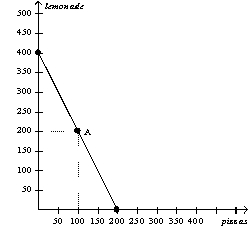
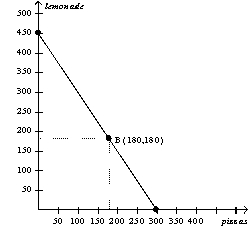 -Refer to Figure 3-10.What are Alice and Betty's opportunity costs of 1 pitcher of lemonade?
-Refer to Figure 3-10.What are Alice and Betty's opportunity costs of 1 pitcher of lemonade?
A) Alice's opportunity cost of 1 pitcher of lemonade is 1/2 of a pizza and Betty's opportunity cost of 1 pitcher of lemonade is 2/3 of a pizza.
B) Alice's opportunity cost of 1 pitcher of lemonade is 2 pizzas and Betty's opportunity cost of 1 pitcher of lemonade is 1.5 pizzas.
C) Alice's opportunity cost of 1 pitcher of lemonade is 10 pizzas and Betty's opportunity cost of 1 pitcher of lemonade is 10 pizzas.
D) Alice's opportunity cost of 1 pitcher of lemonade is 200 pizzas and Betty's opportunity cost of 1 pitcher of lemonade is 300 pizzas.
F) A) and B)
Correct Answer

verified
Correct Answer
verified
Multiple Choice
Table 3-4
Assume that the farmer and the rancher can switch between producing meat and producing potatoes at a constant rate.
 -Refer to Table 3-4.The opportunity cost of 1 pound of meat for the farmer is
-Refer to Table 3-4.The opportunity cost of 1 pound of meat for the farmer is
A) 1/4 pound of potatoes.
B) 1/4 hour of labor.
C) 4 pounds of potatoes.
D) 8 hours of labor.
F) A) and D)
Correct Answer

verified
C
Correct Answer
verified
True/False
It takes Anne 3 hours to make a pie and 4 hours to make a shirt.It takes Mary 2 hours to make a pie and 5 hours to make a shirt.Anne should specialize in making shirts and Mary should specialize in making pies,and they should trade.
B) False
Correct Answer

verified
True
Correct Answer
verified
Multiple Choice
Table 3-3
Assume that Zimbabwe and Portugal can switch between producing toothbrushes and producing hairbrushes at a constant rate.
 -Refer to Table 3-3.Zimbabwe has an absolute advantage in the production of
-Refer to Table 3-3.Zimbabwe has an absolute advantage in the production of
A) toothbrushes and a comparative advantage in the production of toothbrushes.
B) toothbrushes and a comparative advantage in the production of hairbrushes.
C) hairbrushes and a comparative advantage in the production of toothbrushes.
D) hairbrushes and a comparative advantage in the production of hairbrushes.
F) B) and C)
Correct Answer

verified
Correct Answer
verified
Multiple Choice
Comparative advantage is related most closely to which of the following?
A) output per hour
B) opportunity cost
C) efficiency
D) bargaining strength in international trade
F) None of the above
Correct Answer

verified
Correct Answer
verified
Multiple Choice
Suppose that the country of Xenophobia chose to isolate itself from the rest of the world.Its ruler proclaimed that Xenophobia should become self-sufficient,so it would not engage in foreign trade.From an economic perspective,this idea would
A) make sense if Xenophobia had an absolute advantage in all goods.
B) make sense if Xenophobia had no absolute advantages in any good.
C) not make sense as long as Xenophobia had a comparative advantage in some good.
D) not make sense as long as Xenophobia had an absolute advantage in at least half the goods that could be traded.
F) B) and D)
Correct Answer

verified
Correct Answer
verified
Multiple Choice
Table 3-12
 -Refer to Table 3-1.Relative to the farmer,the rancher has an absolute advantage in the production of
-Refer to Table 3-1.Relative to the farmer,the rancher has an absolute advantage in the production of
A) meat,but not in the production of potatoes.
B) potatoes,but not in the production of meat.
C) both meat and potatoes.
D) neither meat nor potatoes.
F) A) and D)
Correct Answer

verified
Correct Answer
verified
Multiple Choice
Table 3-5
Assume that England and Spain can switch between producing cheese and producing bread at a constant rate.
 -Refer to Table 3-5.Assume that England and Spain each has 40 labor hours available.If each country divides its time equally between the production of cheese and bread,then total production is
-Refer to Table 3-5.Assume that England and Spain each has 40 labor hours available.If each country divides its time equally between the production of cheese and bread,then total production is
A) 20 units of cheese and 5 units of bread.
B) 25 units of cheese and 7.5 units of bread.
C) 40 units of cheese and 10 units of bread.
D) 50 units of cheese and 15 units of bread.
F) A) and C)
Correct Answer

verified
Correct Answer
verified
Multiple Choice
Assume for the United States that the opportunity cost of each airplane is 100 cars.Which of these pairs of points could be on the United States' production possibilities frontier?
A) (200 airplanes,5,000 cars) and (150 airplanes,4,000 cars)
B) (200 airplanes,10,000 cars) and (150 airplanes,20,000 cars)
C) (300 airplanes,15,000 cars) and (200 airplanes,25,000 cars)
D) (300 airplanes,25,000 cars) and (200 airplanes,40,000 cars)
F) A) and C)
Correct Answer

verified
Correct Answer
verified
Multiple Choice
Table 3-12
 -Refer to Table 3-1.Relative to the rancher,the farmer has a comparative advantage in the production of
-Refer to Table 3-1.Relative to the rancher,the farmer has a comparative advantage in the production of
A) meat,but not in the production of potatoes.
B) potatoes,but not in the production of meat.
C) both meat and potatoes.
D) neither meat nor potatoes.
F) A) and C)
Correct Answer

verified
Correct Answer
verified
Multiple Choice
Figure 3-3

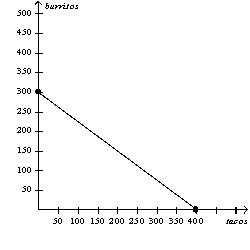
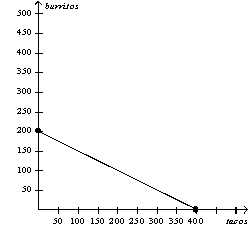 -Refer to Figure 3-3.If the production possibilities frontiers shown are each for one day of production,then which of the following combinations of tacos and burritos could Arturo and Dina together produce in a given day?
-Refer to Figure 3-3.If the production possibilities frontiers shown are each for one day of production,then which of the following combinations of tacos and burritos could Arturo and Dina together produce in a given day?
A) 400 tacos and 350 burritos
B) 500 tacos and 250 burritos
C) 600 tacos and 150 burritos
D) 700 tacos and 100 burritos
F) A) and D)
Correct Answer

verified
Correct Answer
verified
Multiple Choice
Table 3-9
Barb and Jim run a business that sets up and tests computers.Assume that Barb and Jim can switch between setting up and testing computers at a constant rate.The following table applies.
 -Refer to Table 3-9.Barb's opportunity cost of setting up one computer is testing
-Refer to Table 3-9.Barb's opportunity cost of setting up one computer is testing
A) 4/5 computer and Jim's opportunity cost of setting up one computer is testing 3/4 computer.
B) 4/5 computer and Jim's opportunity cost of setting up one computer is testing 4/3 computers.
C) 5/4 computers and Jim's opportunity cost of setting up one computer is testing 3/4 computer.
D) 5/4 computers and Jim's opportunity cost of setting up one computer is testing 4/3 computers.
F) A) and D)
Correct Answer

verified
Correct Answer
verified
Multiple Choice
Figure 3-7

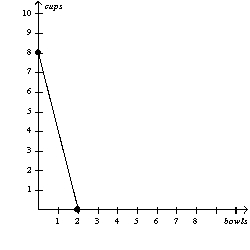
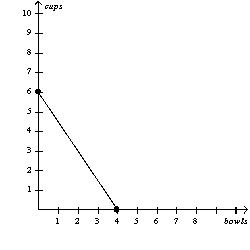 -Refer to Figure 3-7.Suppose Juba is willing to trade one bowl to Bintu for every two cups that Bintu makes and sends to Juba.Which of the following combinations of bowls and cups could Bintu then consume,assuming Bintu specializes in making cups and Juba specializes in making bowls?
-Refer to Figure 3-7.Suppose Juba is willing to trade one bowl to Bintu for every two cups that Bintu makes and sends to Juba.Which of the following combinations of bowls and cups could Bintu then consume,assuming Bintu specializes in making cups and Juba specializes in making bowls?
A) 1 bowl and 7 cups
B) 2 bowls and 4 cups
C) 3 bowls and 3 cups
D) 4 bowls and 1 cup
F) A) and C)
Correct Answer

verified
Correct Answer
verified
Multiple Choice
Table 3-4
Assume that the farmer and the rancher can switch between producing meat and producing potatoes at a constant rate.
 -Refer to Table 3-4.The farmer has a comparative advantage in the production of
-Refer to Table 3-4.The farmer has a comparative advantage in the production of
A) meat.
B) potatoes.
C) both goods.
D) neither good.
F) B) and D)
Correct Answer

verified
Correct Answer
verified
Multiple Choice
Figure 3-11
The graph below represents the various combinations of ham and cheese (in pounds) that the nation of Bonovia could produce in a given month. 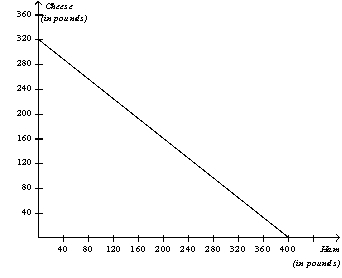 -Refer to Figure 3-11.In the nation of Cropitia,the opportunity cost of a pound of cheese is 1.5 pounds of ham.Based on this information,if Bonovia and Cropitia want to trade,Cropitia should specialize,in the production of
-Refer to Figure 3-11.In the nation of Cropitia,the opportunity cost of a pound of cheese is 1.5 pounds of ham.Based on this information,if Bonovia and Cropitia want to trade,Cropitia should specialize,in the production of
A) ham and import cheese.
B) cheese and import ham.
C) both goods and import neither good.
D) neither good and import both goods..
F) A) and C)
Correct Answer

verified
Correct Answer
verified
Multiple Choice
For a self-sufficient producer,the production possibilities frontier
A) is the same as the consumption possibilities frontier.
B) is greater than the consumption possibilities frontier.
C) is less than the consumption possibilities frontier.
D) is always a straight line.
F) A) and B)
Correct Answer

verified
A
Correct Answer
verified
Multiple Choice
Table 3-8
Assume that Huang and Min can switch between producing parasols and producing porcelain plates at a constant rate.
 -Refer to Table 3-8.The opportunity cost of 1 plate for Min is
-Refer to Table 3-8.The opportunity cost of 1 plate for Min is
A) 1/3 parasol.
B) 1/2 parasol.
C) 2 parasols.
D) 3 parasols.
F) A) and C)
Correct Answer

verified
Correct Answer
verified
Multiple Choice
Table 3-18
Chris and Tony's Production Opportunities
 -Refer to Table 3-18 Chris and Tony both produce tomatoes and pasta sauce.The table shows their possible production per month if both work the same number of 8 hour days.Given this information,Chris's opportunity cost of 1 lb.of tomatoes is
-Refer to Table 3-18 Chris and Tony both produce tomatoes and pasta sauce.The table shows their possible production per month if both work the same number of 8 hour days.Given this information,Chris's opportunity cost of 1 lb.of tomatoes is
A) 2 jars of sauce and Tony's opportunity cost of 1 lb.of tomatoes is 3 jars of sauce.
B) 3 jars of sauce and Tony's opportunity cost of 1 lb.of tomatoes is 2 jars of sauce.
C) 20 jars of sauce and Tony's opportunity cost of 1 lb.of tomatoes is 30 jars of sauce.
D) 30 jars of sauce and Tony's opportunity cost of 1 lb.of tomatoes is 20 jars of sauce.
F) A) and C)
Correct Answer

verified
Correct Answer
verified
Showing 1 - 20 of 426
Related Exams